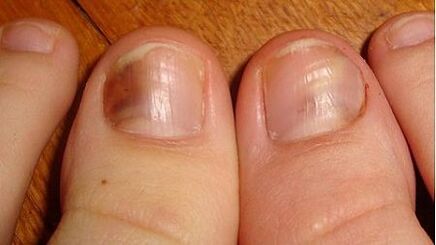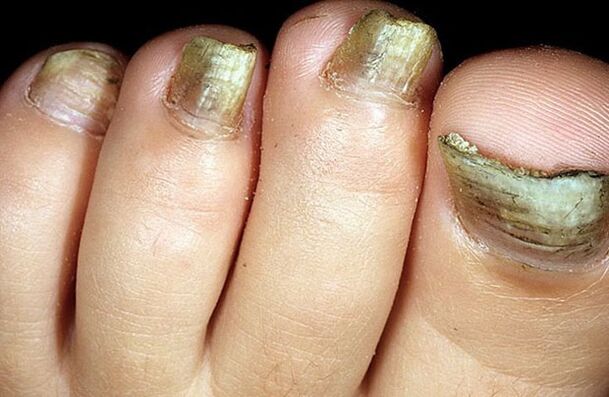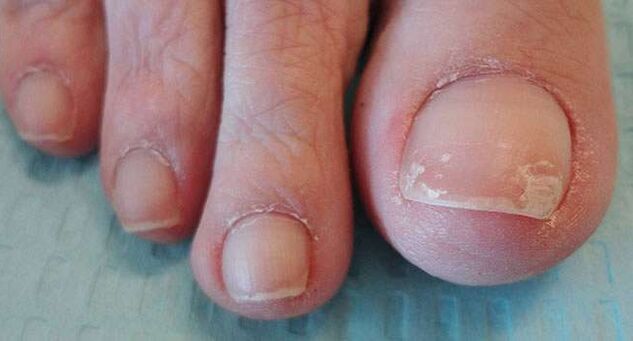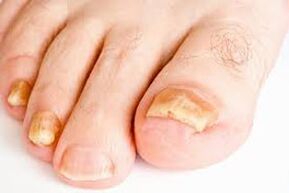A third of people in the world have stratification and crumbling of the nails, clouding of the plate.
This disease is called onychomycosis or nail fungus. It can start at any age, spreads instantly and adapts well to various conditions.
%20and%20fungus-infested%20(right).jpg)
Reasons for the formation of onychomycosis
Infection with a fungus is quite simple. The infection is found inpublic showers, beaches and swimming pools.There is a high risk of contracting onychomycosis in infected loved ones and relatives when using household items together.
There are the following conditions that provoke the entry of the pathogen into the body, in short, the causes of the appearance of the fungus:
- small skin lesions on the feet (corns, corns, small cracks and abrasions) arising from tight shoes;
- weak immunity due to inflammatory and infectious diseases;
- Vascular diseases, dysfunction of internal organs, leading to impaired blood circulation in the legs;
- Violations of safety precautions, ie going barefoot in public places, poor foot hygiene, trying on someone else's shoes;
- ignore profuse sweating and diaper rash on legs.
Important!
Onychomycosis begins on the thumb, later the virus can develop on the little finger.
What diseases can serve as a prerequisite?
The risk group includes people whose skin does not breathe all day due to tight shoes. These include representatives of labor specialties.
The following diseases can serve as a prerequisite:
- Groups diabetes mellitus I and II;
- phlebeurysm;
- foot deformity;
- Obstruction and obstruction of blood vessels.
Nowadays, various creams and varnishes are often offered for treatment, but they are useless, since the cause may lie in internal ailments.
types of infections

In total there are more than half a thousand species of mushroomsbring problems. There is no uniform classification.
The only thing is that there are two important signs by which the disease is distinguished. This is the localization and type of the pathogen.
Important!
The infection can appear in any part of the nail and this is the main symptom of the disease. Externally, the affected plate changes depending on the localization of the virus.
type of pathogen
There are several causative agents of the disease, each of which has its own specifics. These must be taken into account when developing a treatment plan. The most common pathogens are:
- dermatophytes- This is Trichophyton Red and Mentagrophytes, Flaky Epidermophyton and so on. When infected with such fungi, yellowish or grayish spots are formed, the remaining parts of the plate become cloudy, and the free edge changes shade. In general, the entire surface changes, eventually moving away from the bed.
- to form. This species is relatively harmless. It does not penetrate into the deep layers of the nail, and therefore only changes the plates to a dark, swampy, gray, yellowish, brownish color. Such a shade can affect the surface both partially and completely.
- Yeasts of the genus Candida. They thin the nail and contribute to its peeling. Because of this pathogen, a white form of the disease, which is characterized by inflammation of the cuticle, is often formed. They can cause severe pain and observe a purulent discharge. Left untreated, the nail will thin, turn brown, and move completely off the bed.
Places of localization of the disease on the arms, legs
The main forms of onychomycosis:
- Laterally.There is infection of the nail on the sides. Its color becomes gray, yellowed and brownish. The plate begins to cloud, crumble and flake off.
- distalThis is the most common type of mushroom. The infection begins at the free edge of the nail. The plate turns yellow, brown or gray. The loss increases over time. Delamination, crumbling and clouding begin on the plate. In this case, hyperkeratosis occurs under the nails, and if the entire nail is affected, tissue dystrophy develops.
- proximalWith this form, the cuticle is damaged, which swells, becomes inflamed, reddens, and changes its shape and structure. As a result, the roll is separated from the plate, and the nail crumbles, fades and deforms. With a neglected disease, the plate can fall apart completely.
- white surface.It appears, as a rule, on the thumb, on others - occasionally. Externally, it manifests itself in the form of white spots located over the entire surface of the nail. Also, the disease progresses and spreads to keratinized tissues. Spots can change color - from milky to green or yellow. The structure of the plate is spongy and loose. If this form is not treated, the nail can collapse completely.
- The dystrophy is total.It covers the entire nail surface. This is an advanced degree of distal or proximal fungus. The plate becomes thick, changes its shape into an unnatural one, and finally deteriorates completely.
Photo of mycosis on the nails
%20and%20with%20manifestations%20of%20onychomycosis%20(right).jpg)



symptoms of a mycosis
After an infection, the fungus needs time to settle down. First, the disease affects the big toes, destroying the nail plate. Damage is manifested by such signs as:
- Thickening.The plate becomes thicker due to heavy keratinization. In advanced cases, this greatly complicates treatment.
- change hue.In a healthy state, the nail is translucent, and translucent capillaries give a pink color. And the infected changes its hue to black, brown, and yellow. A gap is created under the plate in which microbes and other pathogens develop.
- crumbles.With incomplete treatment or its absence, the fungus begins to penetrate into the deeper layers of the plate. As a result, it crumbles and collapses. If you do not conduct therapy, onychomycosis will become chronic. Because of this, the immune system weakens, allergies begin, and problems with internal organs begin.
How to independently determine, detect the disease?

The fungus first affects one leg, then the infection passes to the second. It is not necessary to delay this disease. If you yourself have doubts and cannot determine the virus, be sure to consult a doctor.
You can diagnose it yourself at home using certain methods.
Find out with potassium permanganate
There is an express method that involves dipping the feet in a solution of potassium permanganate. At the same time, potassium permanganate turns healthy nails brownish, and infected ones remain light.
This procedure is simple and does not take much time. Some potassium permanganate is added to a bowl of warm water. The solution should not be strong. Feet or hands are placed in the liquid and wait about 10 minutes. This method is completely safe. It can not be used only with allergic reactions to potassium permanganate.
Detection with iodine
Iodine is also often used to identify nail fungus. However, it does not indicate the presence of pathogens. It can help eliminate other fungi such as pityriasis versicolor.
If redness and peeling appear on the skin near the nail, they are treated with iodine. Healthy skin does not darken under an alcohol solution, and the area affected by lichen becomes very dark.
How to diagnose?
Today there are several effective diagnostic methods available, probably the most reliable method is the nail fungus test:
- Microbiological diagnostics.Microscopy is the most common method of detecting fungi and determining their type. It allows you to detect infections only in the structure of the nail plate or skin tissue. When a biomaterial is harvested, infected cells are scraped from the area where the pathogen resides.
In the last and middle stage, mycosis spores, yeast cells and mycelial threads are found in the samples. Such diagnostics make it possible to determine the frequency and type of the pathogen. The procedure itself takes from 2 days to a month.
- Linked Immunosorbent Assay. Such an analysis serves to identify fungi that have affected both the nail and the internal organs. The difference is that venous blood is needed to detect the disease, which is taken in the morning or 4 hours after eating. No special preparation is required for the analysis.
- PCR test.The polymerase chain reaction is the best diagnostic method for infectious diseases. It has a number of advantages such asB. speed, greater accuracy and the ability to take any tissue sample. A feature of the procedure is considered a narrow focus. That is, for the diagnosis of onychomycosis it is necessary to know exactly the place of localization. A PCR test can reveal both the type of fungus and its concentration in the body.
- Luminescent study. Such a diagnosis is based on fluoroscopy of the skin affected by pathological microflora with an ultraviolet lamp. When examining a patient, a Wood lamp that emits ultraviolet rays is used. Thanks to her, the products of vital activity begin to shine brightly. The type of pathogen affects the hue of the glow.
How to distinguish mycosis from bruises and other diseases?

At first, onychomycosis is easily confused with other diseases such as ringworm, bruised nails or psoriasis.
It can be distinguished by the darkening of the nail plate, the formation of yellow spots and stripes, which increase in size over time and penetrate deep into the nail.
Compared to psoriasis, onychomycosis develops smoothly. He gradually deforms the plate so that it detaches from the bed. It distinguishes it from injuries, psoriasis, ringworm and eczema, pain and bad smell.
hygiene rules
The best remedy for fungus is prevention.Simple precautions can help prevent infection. First of all, they are needed by people who visit beaches, public pools, saunas, etc. In such places, you should always use single towels and wear light-colored slates.
If your feet sweat a lot, you need to treat them with special means, of which there are many today. It is not recommended to wear shoes that are too tight or use someone else's. Wear overshoes or socks when trying on shoes in the store. Pay attention to the hygiene of feet and hands, and wipe them dry after washing.
If one of the family members is infected with the fungus, he should have a separate washcloth and towel. After visiting the bath, it must be treated with antimicrobial agents. The patient's washcloth should be regularly treated with a 5% chloramine solution, and clothes and towels should be boiled with washing powder.
If infection is suspected, the legs or arms should be immersed in hot water and held for about 10 minutes, the fungus dies off quite quickly at a temperature of +50 ° C. Then these places are smeared with antifungal ointment.
Conclusion
Onychomycosis is an insidious and unpleasant disease, so it is important to monitor your toenails and fingernails and take preventive measures. If you have any suspicious symptoms, it's best to see a doctor as soon as possible and start treatment.


















